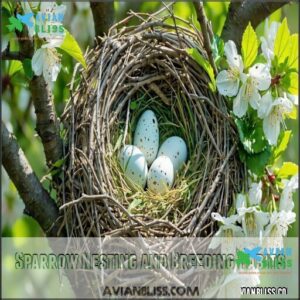This site is supported by our readers. We may earn a commission, at no cost to you, if you purchase through links.

House sparrows, for example, are homebodies—they stay put year-round, even in chilly winters.
However, other sparrows, like the white-throated or chipping sparrows, are seasonal travelers, flying hundreds or even thousands of miles to escape the cold.
Their migration depends on food availability and weather, with some flocking south as early as September and returning by spring.
Think of them as tiny snowbirds, chasing the sun!
These migrations aren’t aimless—sparrows use landmarks and even Earth’s magnetic field to navigate.
Curious where they settle or how climate change affects them? Keep reading to find out!
Table Of Contents
- Key Takeaways
- Sparrow Migration Patterns
- Sparrow Wintering Grounds
- Sparrow Migration Routes
- Effects of Climate Change on Sparrow Migration
- Sparrow Nesting and Breeding Habits
- Deterring Sparrows From Your Property
- Sparrow Conservation Status
- Frequently Asked Questions (FAQs)
- Why do sparrows migrate?
- Where do chipping sparrows migrate?
- How far do sparrows travel?
- Do sparrows migrate in the winter?
- How many birds do sparrows migrate in a flock?
- Are house sparrows migratory?
- What are the Benefits of Sparrow Migration?
- Which is the Best Season to Watch the Sparrow Migration?
- How does Migration Help Sparrows Survive the Winter?
- What do Sparrows Eat During Migration?
- Conclusion
Key Takeaways
- House sparrows are primarily non-migratory, staying in the same areas year-round and adapting to urban environments where they find shelter and food even during winter.
- Many other sparrow species, like white-throated and chipping sparrows, do migrate seasonally, with some traveling up to 2,600 miles to escape harsh weather and find better food sources.
- Sparrows use impressive navigation techniques during migration, including Earth’s magnetic fields, solar orientation, star patterns, and landmark recognition to find their way.
- Climate change is disrupting sparrow migration patterns by altering timing, shifting habitats, and creating extreme weather events that affect their food availability and breeding success.
Sparrow Migration Patterns
You might think sparrows stay put year-round, but some species actually migrate depending on the season.
Their movements are influenced by climate, food availability, and the need for suitable nesting areas.
Do House Sparrows Migrate at All?
House sparrows are mostly sedentary birds, sticking close to home rather than traveling far.
These nonmigratory sparrows excel at adapting to urban environments year-round.
So, do sparrows migrate? Not house sparrows!
Here’s why their urban sparrow movement stays local:
- Food abundance: Cities provide scraps and seeds.
- Warm shelters: Buildings shield sparrows from the cold.
- Seasonal fluff: Feather fluffing traps warmth efficiently.
- Limited migration need: Only harsh climates may force relocation.
They’re hardy survivors of the urban jungle!
How Far Do Sparrows Migrate?
Sparrow migration distances depend on species, climate, and food. Some travel incredible lengths, like White-crowned Sparrows which migrate over 2,600 miles annually. By comparison, Song Sparrows may journey 1,500 miles, while others, like House Sparrows, rarely go more than a few kilometers.
White-crowned Sparrows journey over 2,600 miles, while House Sparrows stay local, rarely traveling beyond a few kilometers.
Female birds tend to migrate slightly farther than males, likely to increase survival odds.
Sparrow migration showcases nature’s resourcefulness.
- Imagine this: braving harsh snowstorms in tiny feathers.
- First-timers often struggle: inexperienced birds risk getting lost or exhausted.
- Climate shifts confuse timing, challenging even seasoned flocks!
What Time of Year Do Sparrows Migrate?
Timing is everything in the context of sparrow migration.
Their seasonal journeys are guided by migration triggers like changing daylight, food supply, and weather impact. You’ll see most sparrows make their fall departure between September and November, moving to warmer spots with better resources. Come March, the spring arrival kicks off as they return to nesting areas and gear up for the breeding season.
Here’s their annual rhythm at a glance:
- Spring: Nesting begins; breeding season is in full swing.
- Summer: Raising chicks becomes the main focus.
- Fall: Juveniles explore; sparrows organize for bird migration.
- Winter: Flexible movements, depending on snow and food.
Understanding sparrow migration patterns highlights their adaptability to nature’s timing.
Sparrow Wintering Grounds
You might wonder where sparrows go in winter, especially when temperatures drop.
While some migrate south to escape the cold, many stay put, relying on urban areas and clever adaptations to survive.
Where Do Sparrows Go During Winter?
When winter rolls in, sparrows don’t travel far; instead, they hunker down in urban winter habitats.
With plenty of cozy shelters like gutters, vents, and roof edges, they comfortably brave the season without long migration journeys.
You might spot flocks of sparrows gathering at bird feeders, fields, or other food sources like discarded grains—key sparrow wintering grounds. This flocking behavior helps them find food and also keeps them warm in numbers.
Their non-migratory adaptations are impressive. They fluff their feathers to trap heat, roost together, and strategically forage.
While certain triggers like food scarcity can influence partial winter migration, house sparrows mostly stay put. So, when asked “do sparrows migrate?” winter rarely moves them southward, due to their ability to fluff their feathers and roost together in a display of flocking behavior.
Do Sparrows Stay in The Same Place Year-Round?
Some sparrows don’t bother heading south for the winter! Many Sedentary Sparrows, especially Urban Sparrows, stick to steady Resident Populations year-round, relying on Local Movements instead of full migration.
Their Non-Migratory Behavior thrives in areas with reliable food and shelter.
Here’s why they stay put:
- Milder winters make travel unnecessary.
- Urban environments offer abundant resources.
- Adaptations help them endure harsh conditions.
So, do sparrows migrate? Not always—some embrace their permanent sparrow wintering grounds with remarkable resilience!
How Do Sparrows Adapt to Winter?
In the icy grip of winter, sparrows rely on ingenious survival techniques instead of long-distance migration.
They employ Feather Insulation, trapping heat like a snug blanket. Blood Constriction reduces heat loss through their legs, while Shivering generates warmth, albeit energy-intensive.
Here’s how they thrive:
- Sunbathing: They soak up warmth, conserving energy.
- Social Feeding: Flocking together helps find food and stay alert.
- Leg Tucking: Curling a leg tight minimizes exposure.
With these clever tactics, sparrows embrace winter’s chill like seasoned pros!
Sparrow Migration Routes
You’ll find that sparrows don’t always follow long migration routes, with some traveling just a few hundred miles.
Their paths often depend on factors like species, food sources, and weather conditions, making each migration unique.
What Month Do Sparrows Typically Migrate?
The timing of sparrow migration can feel like nature’s quiet alarm clock, set by seasonal changes and environmental cues.
For species like the Clay-colored Sparrow, migration triggers kick in around late September or October. These birds don’t stick to dramatic takeoffs but instead follow a gradual, monthly variation.
Sparrow departure aligns with dropping temperatures and shrinking food supplies as they search for better wintering grounds. You’ll notice mild flocks moving rather subtly—certainly not the flashy migrations of larger birds.
Peak migration for some species weaves seamlessly into fall’s rhythm, showcasing one of bird migration’s understated yet essential, seasonal patterns. Some birds use Earth’s magnetic field to navigate, utilizing this natural phenomenon to guide their migration.
Do Sparrows Follow The Same Migration Route Every Year?
Sparrow migration routes aren’t carved in stone. Instead, they adjust based on nature’s curveballs, showcasing a balance of learned routes and genetic routes.
Their route fidelity adapts due to:
- Weather variations: Sudden storms or unexpected cold pushes sparrows to alter paths.
- Shifting food sources: New feeding grounds lead to route changes over time.
- Habitat disruptions: Construction or deforestation forces flocks to explore new migration patterns.
This flexibility guarantees their route accuracy, helping them thrive during uncertain bird migration cycles.
How Do Sparrows Navigate During Migration?
Finding their way across long migration routes isn’t guesswork for sparrows—it’s a mix of incredible navigational abilities and instinct.
Sparrows navigate migration using Earth’s magnetic fields, solar cues, and stars, blending instinct and nature’s map for their journeys.
They use Earth’s magnetic fields as a built-in compass, letting them sense direction even on cloudy days. During daylight, solar orientation helps them adjust their course using the sun’s position.
At night, sparrows follow navigation cues from the stars, almost like celestial GPS. Familiar landmarks, such as rivers or forests, serve as mental roadmaps to guide their migration navigation over known areas.
Plus, social learning means young birds learn traditional migration routes from experienced adults. There’s even a touch of genetic factors at play, guaranteeing sparrows “know” where to go.
Together, these mechanisms guarantee survival and reliable migration patterns year after year.
Effects of Climate Change on Sparrow Migration
Climate change is disrupting the timing and routes of sparrow migration, making their seasonal journeys less predictable.
As temperatures shift and food sources become unreliable, sparrows are forced to adapt in ways that could affect their survival.
How Does Climate Change Impact Sparrow Migration Patterns?
As Earth’s climate warms, sparrow migration patterns shift unexpectedly.
These tiny birds, guided by light and weather, now face "Altered Timing" in journeys, missing key breeding windows. "Shifting Habitats" add challenges, forcing sparrows into crowded spaces with intense resource competition.
Meanwhile, "Extreme Weather" like storms and frosts disrupt "migration behavior," scattering flocks and shortening routes.
Food Scarcity hurts long flights when crops fail or insects vanish. Understanding bird navigation methods is essential for predicting how these species will adapt.
By understanding climate’s ripple effects, you’ll see how sparrows adapt to unpredictable changes!
- Warmer winters delay flights
- Lost stopovers worsen hardship
- Habitat changes increase risks
Are Sparrows Affected by Changing Weather Conditions?
In the context of weather impacts, sparrows tackle challenges head-on, but they’re not invincible.
Shifting climates impact sparrow migration, pushing these adaptable birds to their limits. Food scarcity, erratic storms, and habitat changes drive behavioral shifts across populations.
- Unpredictable migration shifts emerge with urban heat islands delaying their usual routes.
- Extreme weather events disrupt food availability, forcing sparrows to expand territories.
- Prolonged mild winters can halt migration altogether, leaving them vulnerable to sudden cold snaps.
- Heatwaves push sparrows into shaded urban areas, affecting rural habitats.
- Rainfall intensity alters nesting success and chick survival rates.
Even resilient sparrows struggle with the effects of climate change on bird migration.
Sparrow Nesting and Breeding Habits
You’ll find sparrows building their nests in sheltered spaces, choosing spots that offer protection and proximity to food.
Breeding typically happens during spring and summer, when conditions are ideal for raising their young, particularly in terms of protection.
How Do Sparrows Choose Their Nesting Locations?
Safe nesting sites are top-of-mind for sparrows, prioritizing protection from predators and comfort.
They adapt quickly to various environments, including urban spaces, seeking spots like roof gaps, tree hollows, or even planter corners.
Their choice hinges on food availability, predator avoidance, and social cues.
Sparrows choose nesting materials carefully, favoring twigs, grasses, and feathers to craft sturdy nests.
These adaptable birds also benefit from urban adaptation, finding ingenious ways to raise chicks near human activity.
To guarantee successful incubation, they often seek locations that provide optimal temperature regulation.
- Tip: Want sparrows around? Add shrubs, trees, or birdhouses to your yard to mimic natural nesting sites while also supporting their survival needs.
What Time of Year Do Sparrows Typically Breed?
During warmer months, sparrows kick off their families’ beginnings with a bustling breeding season, typically from April to August.
This Breeding Seasonality aligns with abundant food and daylight, enhancing their chances of success.
Sparrows energetically build nests and lay eggs in cycles, often producing multiple broods.
Their Clutch Size varies, but dedicated parental care guarantees Nestling Development progresses smoothly.
While one mate incubates, the other seeks food, playing a balancing act.
Early broods thrive in spring, while summer broods face challenges like heat and limited resources.
These adaptable birds prove resilient, adjusting bird migration patterns and behaviors over time.
Do sparrows migrate? Some species stay year-round instead!
Deterring Sparrows From Your Property
If sparrows are causing trouble around your property, there are effective ways to manage their presence without harm.
By using simple deterrents and adjusting the environment, you can prevent these adaptable birds from settling where they’re not welcome.
How to Keep Sparrows Away From Your Home
Sparrows can overstay their welcome when they make your home theirs.
To discourage house sparrows effectively without harm, try these smart tips:
- Seal up gaps: Block entry to vents, eaves, and crevices to prevent nesting. Simple property modifications can stop sparrows cold.
- Trim and tidy: Keep shrubs and trees pruned, avoiding overly cluttered urban habitats that encourage nesting.
- Limit food sources: Use bird feeders designed for larger birds and clean up spilled seeds around feeding areas.
- Noise or physical repellents: Motion-activated devices or reflective materials can deter sparrows while staying eco-friendly.
These simple strategies reduce sparrow activity, blending nest removal, effective deterrents, and subtle repellent options to restore harmony and protect outdoor spaces.
Consider exploring various sparrow deterrent options for your home.
What Are The Best Deterrents for Sparrows?
Keeping sparrows from overtaking your property can be surprisingly simple with the right deterrents. Combining Visual Deterrents, Auditory Methods, and Physical Barriers helps create an environment sparrows find less appealing.
Reflective tape, scary balloons, or shiny Mylar strips unsettle sparrows by mimicking predators or strange light patterns. Ultrasonic emitters silently discourage them, perfect for patios or gardens. Physical Barriers like bird spikes or mesh netting block perching and nesting spaces—protecting your ledges and eaves.
Consider using specialized bird tape for the best results. Smart strategies like removing food scraps near bird feeders and reducing dense vegetation disrupt sparrows’ sense of security.
Take a look at these options:
| Deterrent | Purpose |
|---|---|
| Reflective tape | Disorients with light and movement |
| Bird spikes | Blocks roosting spots |
| Ultrasonic devices | Emits unsettling sounds silently |
| Food cleanup | Reduces overall sparrow attraction |
A thoughtful setup makes sparrows ponder, “Should we migrate somewhere else?”
How to Remove Sparrows From Your Property
When sparrows overstay their welcome, you can gently encourage their relocation while respecting their role in nature.
Here’s a practical approach:
- Seal Entry Points: Use durable mesh or weatherproof nets to block access to vents, eaves, or ledges, reducing sparrow habitat opportunities.
- Apply Sparrow Deterrents: Reflective tape, wind chimes, or ultrasonic devices create an environment sparrows won’t enjoy.
- Introduce Alternative Birdhouses: Place birdhouses or nest boxes away from key areas, offering sparrows a safe spot without interfering with your space.
- Opt for Humane Removal: For persistent visitors, humane traps allow safe relocation.
Regularly clean bird feeders and reduce crumbs to further limit nesting.
If challenges persist, consult professional help for expert nest removal and sparrow exclusion.
Sparrow Conservation Status
You mightn’t realize it, but sparrow populations are facing real challenges in the wild due to habitat loss and climate change.
Understanding their conservation status can help you protect these adaptable but vulnerable birds for future generations.
Is The House Sparrow a Species of Conservation Concern?
The House Sparrow isn’t currently listed as endangered, but its decline raises concerns about broader ecosystem impacts.
While globally abundant and marked as "Least Concern," house sparrows face unique challenges.
Urban development, with fewer natural nesting spots and green spaces, limits essential habitat.
On top of that, invasive species and urban predators, like cats, add extra pressure, further shrinking bird populations.
Modern farming practices, particularly pesticide use and monocultures, reduce food availability across sparrow species.
Though adaptable, house sparrows aren’t immune to climate change, which disrupts migration and breeding cycles.
Conservation efforts, such as installing artificial nests and planting urban greenery, show promise for reversing the House Sparrow decline.
Their diet includes waste grain and seeds, which are affected by farming practices.
Interestingly, their resilience and habitat adaptability continue to surprise researchers, offering hope.
Supporting house sparrows isn’t just bird conservation—it’s about securing biodiversity and ensuring balanced ecosystems for all.
What Threats Do Sparrows Face in The Wild?
Nature throws plenty at these little birds, and it’s not just storms they weather.
- Predation Pressure: Cats and hawks treat them like feathered snacks.
- Habitat Loss: Urban sprawl leaves nesting spots as rare as unicorns.
- Food Scarcity: Pesticide exposure wipes out seeds and bugs they depend on.
- Climate Change: Warmer winters mess with instincts, altering migration rhythms.
- Urban Hazards: Windows and cars turn flight paths into obstacle courses.
Life’s no easy perch. Many homeowners seek sparrow deterrent solutions to manage local populations.
How Can You Help Conserve Sparrow Populations?
When sparrows face habitat loss and food shortages, your backyard can become a lifesaver. Simple actions can make all the difference. By creating welcoming spaces, you’re not just helping sparrows survive—you’re aiding bird conservation efforts globally.
- Provide vegetation like native shrubs and trees for natural shelter and food.
- Install birdhouses to give sparrows safe, snug nesting spots.
- Use appropriate feeders filled with millet, sunflower seeds, and other sparrow favorites.
- Offer a consistent water source for drinking and splashing, especially in winter.
- Reduce threats by avoiding pesticides and ensuring cat-free zones near nesting areas.
These tips support sparrow migration habitats, offering rest stops for traveling birds. You could also participate in habitat restoration projects to further enhance their environment. Every step you take strengthens bird migration conservation and creates safer, thriving bird habitats right in your own backyard.
Frequently Asked Questions (FAQs)
Why do sparrows migrate?
They migrate to avoid cold winters, find warmer climates, and access better food sources.
It’s a survival strategy, ensuring they escape harsh weather, scarce resources, and predators while returning north to breed in spring.
Where do chipping sparrows migrate?
It’s fascinating how chipping sparrows travel south for winter, heading to Mexico or the southern U.S., then gracefully return to their northern breeding grounds, like Canada, each spring.
They follow warmer climates and food supplies.
How far do sparrows travel?
Sparrows typically travel only a few miles, staying close to their nesting areas.
However, some migratory species can cover hundreds of miles, depending on food availability, climate, and specific seasonal needs.
Do sparrows migrate in the winter?
Imagine staying in freezing temperatures without a winter coat—sparrows won’t take that risk.
While some species stick around, many head south, escaping harsh winters to find food and warmth, ensuring their survival till spring, which is crucial for their survival.
How many birds do sparrows migrate in a flock?
You’ll typically see sparrows migrating in small flocks of 10-20 birds, though some groups may be larger.
This size helps them stay safer from predators while efficiently covering long distances together.
Are house sparrows migratory?
House sparrows aren’t big travelers.
They’re mostly non-migratory, sticking close to where they nest year-round.
At most, they’ll move a few kilometers, relying on human food and shelter in urban areas to survive.
What are the Benefits of Sparrow Migration?
Migration helps sparrows survive harsh winters, escape predators, and find food.
It supports nesting success, reduces resource competition, and aids ecosystems by controlling pests.
This seasonal journey enhances their adaptability and long-term survival.
Which is the Best Season to Watch the Sparrow Migration?
Spring and fall present your best opportunities to witness sparrow migration, with over 1 billion birds on the move.
You’ll see the most activity during early mornings in April-May and again in September-October, which are the best times for this phenomenon.
How does Migration Help Sparrows Survive the Winter?
By relocating to warmer southern regions, you’ll find that sparrows escape harsh northern conditions, conserve energy, and gain access to more abundant food sources.
They’re basically nature’s smart travelers beating winter’s challenges.
What do Sparrows Eat During Migration?
During migration, you’ll notice sparrows feast on seeds, grains, insects, and berries.
They’ll adapt their diet based on available resources, often stopping at fields, gardens, and backyard feeders to refuel their journey.
Conclusion
Ultimately, understanding whether sparrows migrate is like putting together a feathered puzzle—it depends entirely on the species.
While house sparrows typically stay put year-round, many other sparrow species do migrate seasonally to find food and suitable habitats.
You’ll notice these patterns changing as climate shifts impact their traditional movements.
By observing these small birds in your neighborhood throughout the seasons, you’ll gain appreciation for their remarkable adaptability and survival strategies. Remember: when asking do sparrows migrate, the answer is both yes and no.
- https://www.thespruce.com/pictures-of-sparrows-4121969
- https://www.sciencedaily.com/releases/2019/04/190416081407.htm
- https://www.rspb.org.uk/birds-and-wildlife/natures-home-magazine/birds-and-wildlife-articles/migration/dangers-of-migration/
- https://www.bbc.com/news/science-environment-57150571
- https://www.allaboutbirds.org/guide/House_Sparrow/overview














